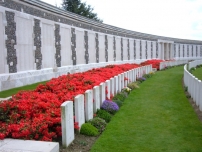| First Name: | William | Last Name: | WHITBREAD | |
|---|---|---|---|---|
| Date of Death: | 10/11/1917 | Lived/Born In: | Mitcham | |
| Rank: | Private | Unit: | South Wales Borderers1 | |
| Memorial Site: | 1. Mitcham Memorial 2. Tyne Cot Memorial, Belgium | |||
Current Information:Age-30 13, Prussia Place, Lower Mitcham
Third Battle of Ypres This was a campaign fought between July and November 1917 and is often referred to as the Battle of Passchendaele, a village to the north-east of Ypres which was finally captured in November. It was an attempt by the British to break out of the Ypres salient and capture the higher ground to the south and the east from which the enemy had been able to dominate the salient. It began well but two important factors weighed against them. First was the weather. The summer of 1917 turned out to be one of the the wettest on record and soon the battlefield was reduced to a morass of mud which made progress very difficult, if not impossible in places. The second was the defensive arrangements of concrete blockhouses and machine gun posts providing inter-locking fire that the Germans had constructed and which were extremely difficult and costly to counter. For 4 months this epic struggle continued by the end of which the salient had been greatly expanded in size but the vital break out had not been achieved. The Second Battle of Passchendaele. 26 October, 1917–10th November, 1917 Although all the fighting during Third Ypres is often referred to as the Battle of Passchendaele, that name officially belongs to two battles fought late in the campaign. The second of these, the final battle of the campaign, was fought between 26th October and 10th November, 1917, when Canadian and British troops of Second Army attacked the Passchendaele ridge, capture of which would have given them sight of the important railway junction at Roulers, a vital part of the German supply network. At the same time, units from Fifth Army attacked further north. The battle was a success inasmuch as the high ground along the Passchendaele-Westrozebeke ridge ended up in British hands but once again the casualty rate was very high. At this stage and much to Field Marshall Haig’s chagrin, some British divisions were withdrawn from Flanders and sent to Italy to assist the Italian Army after their defeat at the Battle of Caporetto, while others were removed to take part in the forthcoming offensive at Cambrai. As a result of this the whole campaign of 3rd Ypres was terminated. The final act of the whole campaign came on 10th November, 1917, when, true to form, the heavens opened once again and the rain poured down. The Canadians attacked from the ruins of the village of Passchendaele, which they had captured a few days earlier, and took the ridge beyond it. At the same time and to their left, 1st Division launched an offensive against the main ridge north of Goudberg. 1st South Wales Borderers and 2nd Royal Munster Fusiliers, both of 3 Brigade, were the battalions involved but things did not go well. As they advanced 1st South Wales Borderers veered to the right and a gap opened up between the two battalions and when the enemy counter attacked at 7.15am they were able to exploit this gap. To begin with 2nd Munster had been going well. They had taken their first objectives but they had then pushed too far forward towards the main ridge and were hit by their own artillery. Now, with the Germans advancing into the gap, they found themselves cut off and being pushed back. On their right 1st South Wales Borderers found themselves in a similar situation and both battalions were eventually forced back to their starting lines where they continued to suffer from the heavy enemy shelling. Between them they suffered over 800 casualties in this futile operation. One of those killed was William Whitbread of 1st South Wales Borderers. |
||||
| « Back to Search Results | ||||
| If you think any of the information shown here is incorrect, Click Here to submit your amends and comments | ||||




